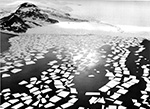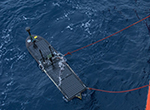|
Science - Oceans and Atmosphere Most Recent
Quick Find
More ResultsJul
28
2020
Chasing Aerosol GhostsScience | Oceans and Atmosphere For a big mass of air, the Earth's upper atmosphere is a complicated place. The changing seasons cause temperatures and pressures to rise and fall, altering the characteristics of the planet's atmospheric layers, sometimes dramatically. May
07
2019
Icefin Tests the WatersScience | Oceans and Atmosphere Navigating a robot through the frozen ocean's frigid waters was all in a day's work for the RISE UP science team. From their makeshift mission control in a small fish hut, the researchers maneuvered their underwater vehicle through the seawater below. Nov
20
2018
New Ocean Floats Deepen a Carbon-Cycle MysteryScience | Oceans and Atmosphere A new network of automated instruments throughout the Southern Ocean, which surrounds Antarctica, is dramatically changing how scientists view the planet's least understood ocean. Jan
08
2018
Quantifying SnowfallScience | Oceans and Atmosphere Snow in some form or another blankets almost all Antarctica, but measuring exactly how much snow falls from the sky is tricky. A team of researchers recently set up four newly-developed precipitation observatories near McMurdo Station to better measure how much snow falls in the region. May
24
2017
Methane Munching MicrobesScience | Oceans and Atmosphere VIDEO: Five years ago, a plume of natural methane started seeping out of the seafloor near McMurdo Station, providing researchers an unprecedented chance to study the formation and development of colonies of microorganisms that rely on methane for nourishment. Jan
04
2017
The Cosmic Dust SuckerScience | Oceans and Atmosphere The Earth is constantly showered with micrometeorites, every minute of every day. These interstellar particles are no bigger than a grain of sand, but are falling out of the sky everywhere. Collecting this cosmic dust, and separating it from terrestrial contamination, has led scientists to the most remote corner of the planet. Jul
11
2016
A Robotic Rehearsal for Interplanetary ExplorationScience | Oceans and Atmosphere It is no small undertaking to design and build a 25-foot-long underwater robot, launch it through a narrow hole drilled through 20 feet of sea ice, allow it to maneuver autonomously through several kilometers of Antarctic Ocean for hours at a time and program it to pilot itself back to within a few feet of where it started. The simple part is that it at least takes place on planet Earth. May
12
2016
Keeping Scientists AWARE of the West Antarctic ClimateScience | Oceans and Atmosphere AWARE, the ARM West Antarctic Radiation Experiment (AWARE) is a part of the Department of Energy's Atmospheric Radiation Measurement Program (ARM). The National Science Foundation (NSF), which manages the U.S. Antarctic Program is facilitating its installation. The cluster of white shipping containers perched atop the hill near McMurdo Station may well represent the densest cluster of weather monitors Antarctica has ever seen. May
04
2016
The Southern Ocean's Carbon Sink Stronger than EverScience | Oceans and Atmosphere The waters around Antarctica seem to have reversed a troubling trend. Bucking predictions, observations now show that the Southern Ocean is pulling more carbon dioxide out of the atmosphere than ever recorded, which could have implications for predicting the rate of climate change. Oct
28
2015
El Nino in AntarcticaScience | Oceans and Atmosphere If the weather at the bottom of the world seems a little out of whack this year, blame El Nino. Every few years, the ocean around the eastern and central Pacific warms a few degrees, disrupting weather patterns across the ocean from Alaska to Antarctica. Scientists at the National Oceanographic and Atmospheric Administration are predicting that this year's El Nino will be a particularly strong one. Dec
05
2014
Salt SprayScience | Oceans and Atmosphere A team of atmospheric scientists, led by Lars Kalnajs at the University of Colorado at Boulder and Peter DeCarlo at Drexel University, are making some of the first real-time measurements of aerosol size and composition in Antarctica. Oct
09
2014
ExpansionScience | Oceans and Atmosphere Sea ice around Antarctica appears headed for another record year. NSIDC, partly funded by the National Science Foundation, reported that the five-day average for sea ice extent around the southernmost continent last month had already surpassed 20 million square kilometers for the first time in the modern satellite record. Sep
11
2014
High-Water MarkScience | Oceans and Atmosphere The National Science Foundation (NSF) is providing support to help launch a $21 million interdisciplinary initiative involving 11 institutions across the United States to study the Southern Ocean around Antarctica.
|
||||||||||||||||||||||||||||||



For USAP Participants |
For The Public |
For Researchers and EducatorsContact UsU.S. National Science FoundationOffice of Polar Programs Geosciences Directorate 2415 Eisenhower Avenue, Suite W7100 Alexandria, VA 22314 Sign up for the NSF Office of Polar Programs newsletter and events. Feedback Form |



